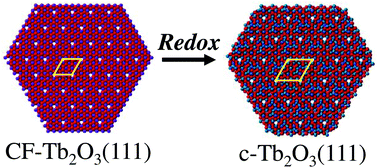Redox-mediated transformation of a Tb2O3(111) thin film from the cubic fluorite to bixbyite structure†
Abstract
We used temperature programmed desorption (TPD) and low energy electron diffraction (LEED) to investigate the isomeric structural transformation of a Tb2O3 thin film grown on Pt(111). We find that repeated oxidation and thermal reduction to 1000 K transforms an oxygen-deficient, cubic fluorite (CF) Tb2O3(111) thin film to the well-defined bixbyite, or c-Tb2O3(111) structure, whereas annealing the CF-Tb2O3(111) film in UHV is ineffective in causing this structural transformation. We estimate that the final stabilized film consists of about ten layers of c-Tb2O3(111) in the surface region plus about eight layers of CF-Tb2O3(111) located between the c-Tb2O3(111) and the Pt(111) substrate. Our measurements reveal the development of two distinct O2 TPD peaks during the CF to bixbyite transformation that arise from oxidation of c-Tb2O3 domains to the stoichiometrically-invariant ι-Tb7O12 and δ-Tb11O20 phases and demonstrate that the c-Tb2O3 phase oxidizes more facilely than CF-Tb2O3. We present evidence that nucleation and growth of c-Tb2O3 domains occurs at the buried TbOx/CF-Tb2O3 interface, and that conversion of the interfacial CF-Tb2O3 to bixbyite takes place mainly during thermal reduction of TbOx above ∼900 K and causes newly-formed c-Tb2O3 to advance deeper into the film. The avoidance of low Tb oxidation states may facilitate the CF to bixbyite transformation via this redox mechanism.



 Please wait while we load your content...
Please wait while we load your content...